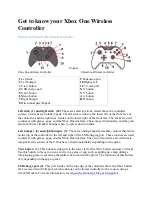
9.8.3 Industrial Ethernet: Table Row and Column Descriptions
The following are table row and column descriptions (listed in alphanumeric order) for the register maps found in the
Industrial Ethernet tab of the Software and the
Table 6: Data Types
Data Type
Description
UINT
Unsigned integer—16 bits
UDINT
Unsigned double integer—32 bits
Word
Bit string—16 bits
Dword
Bit string—32 bits
String
Two ASCII characters per Word (see protocol-based String information below)
Octet
Reads as each byte translated to decimal separated by a dot
Hex
Reads as each nibble translated to hex, paired, and then separated by a space
Byte
Bit string—8 bits
Byte:Bit
Indicates the byte offset followed by the specific bit.
Fault Flag
If the particular input or output being tracked causes a lockout, a flag associated with that virtual output will be set
to 1. In Modbus/TCP, this can be read as a discrete input, input register, or holding register.
Fault Index
If the Fault Flag bit is set for a virtual output, the Fault Index will contain a number, which translates to a Fault
Code. For example, a Fault Index 41, can contain a number 201, which translates to the Fault Code 2.1; the
number 412 would translate to the Fault Code 4.12 (see
on page 148 and
on page 151for more information).
Function
The function that determines the state of that virtual output.
Operating Mode
Operating Mode
Value
Description
1 (0x01)
Normal Operating Mode (including I/O faults, if present)
2 (0x02)
Configuration Mode
4 (0x04)
System Lockout
65 (0x41)
Waiting For System Reset/Exiting Configuration Mode
129 (0x81)
Entering Configuration Mode
Reg:Bit
Indicates the offset from 30000 or 40000 followed by the specific bit in the register.
Reserved
Registers that are reserved for internal use.
Seconds Since boot
The time, in seconds, since power was applied to the Safety Controller. May be used in conjunction with the
Timestamp in the Fault Log and a real time clock reference to establish the time when a fault occurred.
String (EtherNet/IP and PCCC Protocol)
The default format EtherNet/IP string format has a 32 bit length preceding the string (suitable for ControlLogix).
When configuring the Network Settings using the Software, you can change this setting to a 16 bit length which
corresponds to the standard CIP “String” under the Advanced menu. However, when reading an Input Assembly
that includes a string with a 16 bit length, the string length will be preceded by an extra 16 bit word (0x0000).
The string itself is packed ASCII (2 characters per word). In some systems, the character order may appear
reversed or out of order. For example, the word “System” may read out as “yStsme”. Use "
Swap character bytes
"
option under the Advanced menu in the Network Settings window to swap characters so words read correctly.
XS/SC26-2 and SC10-2 Safety Controllers
www.bannerengineering.com - Tel: + 1 888 373 6767
105
















































